The world of vehicle protection has evolved significantly in recent years, largely due to advances in materials used for Car Covers and Motorcycle Covers. As consumer awareness grows and environmental factors become more demanding, buyers are increasingly interested in understanding what sets modern cover materials apart from earlier generations. From enhanced durability to climate adaptability, material innovation plays a crucial role in providing effective vehicle protection.

One of the notable developments is the use of multi-layered fabrics in Car Covers. These advanced materials are often composed of multiple bonded layers, each serving a specific purpose. For example, the outer layer may be designed for UV resistance, the middle layer for water repellency, and the inner layer for softness to prevent scratching the paint. This layered approach helps improve both performance and longevity, especially in variable weather conditions common in many regions.
In the case of Motorcycle Covers, material selection is equally important. Since motorcycles have exposed parts like chains, brakes, and controls, covers must protect against water intrusion while remaining breathable enough to prevent condensation buildup. Many modern motorcycle covers now use advanced polyester blends or specialized Oxford fabric treated with PU or PVC coatings. These treatments enhance water resistance while maintaining flexibility and ease of handling.
Another innovation in Car Covers is the incorporation of reflective coatings and heat-resistant finishes. For vehicles parked in direct sunlight, especially in warmer climates, these features help deflect solar energy and reduce interior temperatures. This can be particularly beneficial for preserving dashboard materials, seat upholstery, and electronic components. Heat-resistant layers also minimize the risk of cracking or warping, issues that commonly affect uncovered cars left in high temperatures for extended periods.
Motorcycle Covers have also benefited from similar enhancements. Reflective strips are now commonly integrated into the design, improving visibility in low-light areas such as parking garages or alleyways. This small yet practical addition helps reduce the chance of accidents and ensures that the parked motorcycle is noticed by pedestrians or other vehicles.
Breathability is another essential characteristic in the evolution of both Car Covers and Motorcycle Covers. Trapped moisture can cause mold, mildew, and rust, particularly in humid or coastal environments. Today’s high-quality materials include microscopic pores that allow moisture to escape while keeping rain and contaminants out. This balance of protection and airflow is critical for maintaining the condition of both the vehicle’s exterior and the parts beneath.
Weight and storage are also factors influenced by material technology. Newer fabrics are not only more durable but also lighter and easier to fold, making covers more convenient for everyday use. Whether it’s a full-sized SUV or a compact motorcycle, users now have access to covers that are easy to handle without sacrificing strength or protection.
Additionally, the rise of environmentally conscious manufacturing has led to the development of recyclable and eco-friendly materials for both Car Covers and Motorcycle Covers. These materials reduce the environmental impact while still offering reliable performance. Some covers are now made from biodegradable components or recycled plastics, appealing to buyers who prioritize sustainability alongside functionality.
The material innovation continues to shape the future of Car Covers and Motorcycle Covers. Buyers today have access to a wide range of options that cater to specific environmental conditions, vehicle types, and personal preferences. Understanding the properties of these materials allows consumers to make informed choices that enhance protection, convenience, and longevity.




 English
English 中文简体
中文简体 Español
Español













